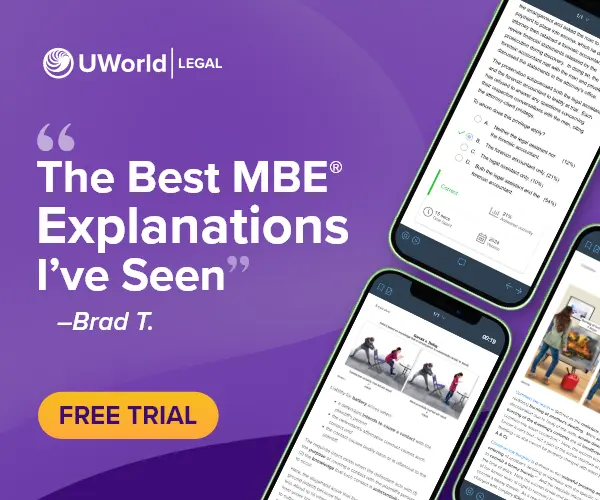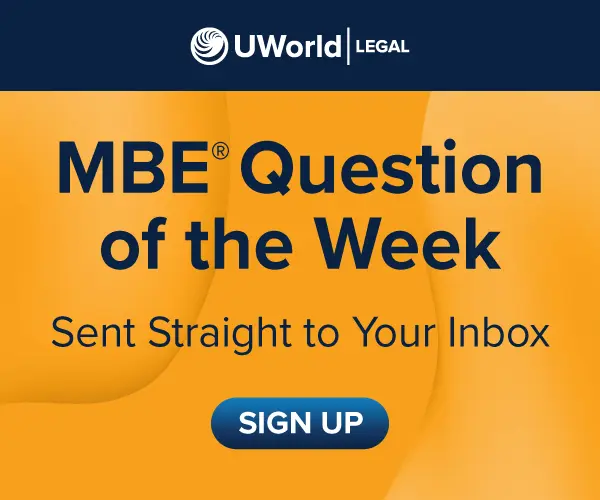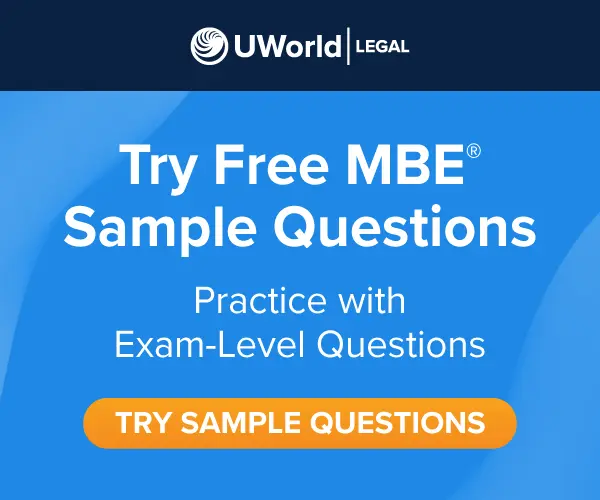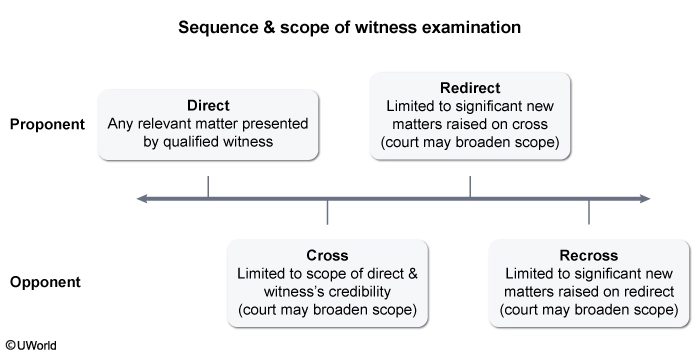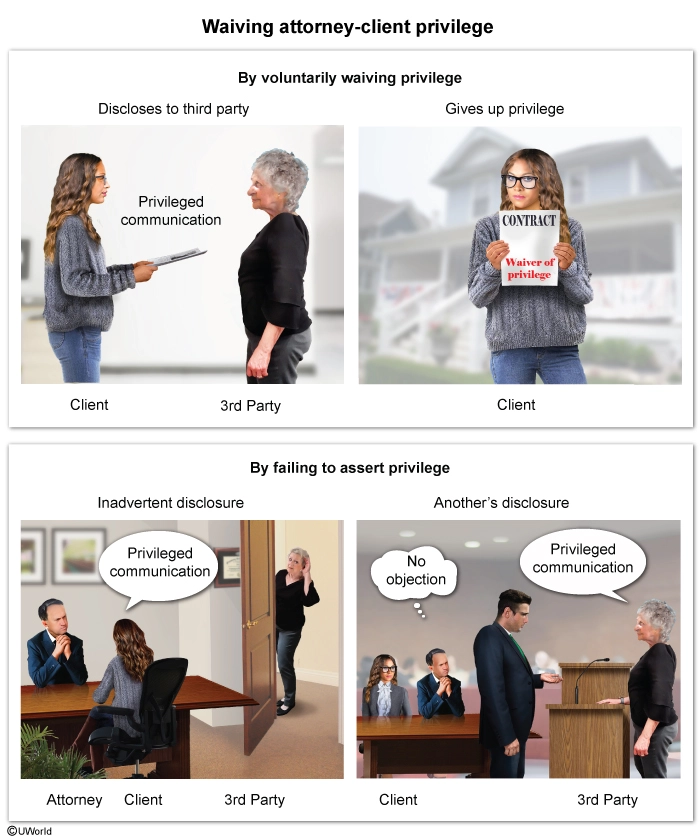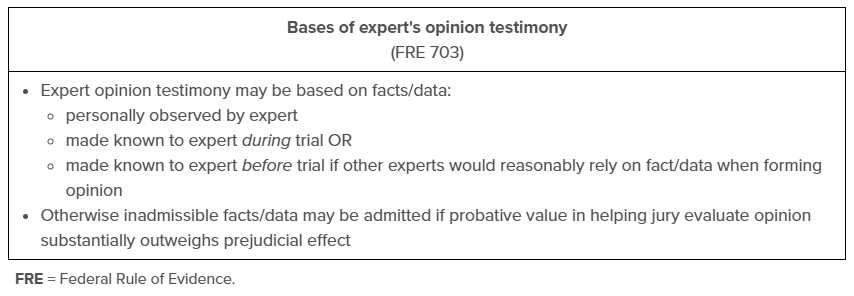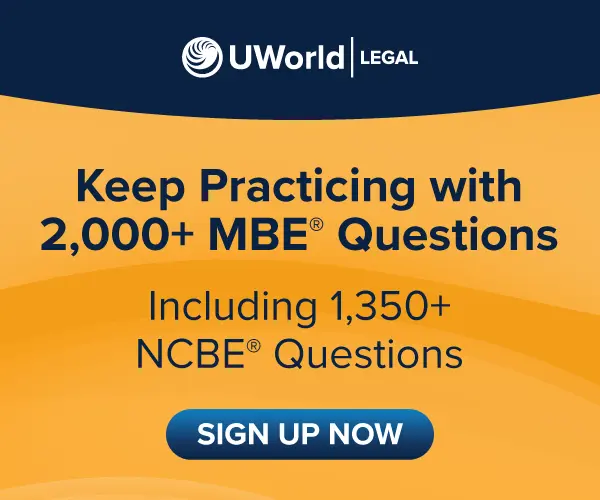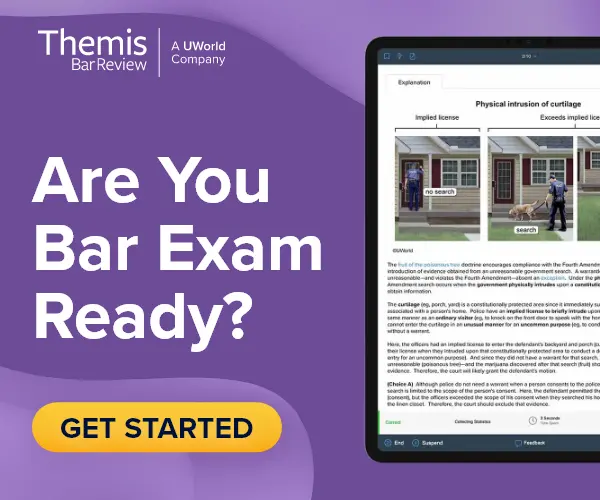Evidence is 1 of 5 topics tested on the MBE. The exam contains 25 questions relating to Evidence and emphasizing relevance, hearsay, witness impeachment, and character evidence. You can expect about 8 or 9 questions about relevancy, with another 6 or 7 about hearsay and presentation.
Evidence Breakdown
The National Conference of Bar Examiners (NCBE®) emphasizes questions about relevancy and the reasons for excluding relevant evidence because it requires you to demonstrate legal reasoning based on a fact pattern. Without the determination of relevancy, evidence such as photographs and oral testimony is irrelevant. Here’s how the subtopics on evidence are graded:
| Evidence Subtopics | % Tested | No. of Questions |
|---|---|---|
| Relevancy and reasons for excluding relevant evidence | 33.3% | 8-9 |
| Hearsay and circumstances of its admissibility | 25.0% | 6-7 |
| Presentation of evidence | 25.0% | 6-7 |
| Privileges and other policy exclusions | 8.3% | 2 |
| Writings, recordings, and photographs | 8.3% | 2 |
| Total Scored Questions for Evidence | 25 | |
Reasons for Excluding Relevant Evidence
A piece of court evidence must be authenticated when submitted for admission, with the submitter providing significant proof that the evidence is what they state it to be. Relevant evidence may be excluded if its prejudicial effect outweighs its probative value. Even if the evidence is relevant, it may be excluded if it's considered confusing, prejudicial, or deemed a complete waste of time.
Character Evidence
Character evidence is generally inadmissible, but exceptions do exist. It is brought into question when a defendant raises an issue with character. This is not because it's irrelevant but because it heavily relies on persuading the jury to overlook a potentially bad history to judge this specific case. There are 3 methods of proving character:
- Get a witness' testimony about a person's trait within the community.
- Get a witness with personal knowledge of the pertinent trait.
- The witness testifies about specific instances of a person's behavior that infer character.
A routine business practice or a person's habits may be admitted to prove that the person in question is in line with their routine. This can be admitted to the court without corroboration or eye witness.
Expert Testimony
Expert testimony is stated during a trial by a witness on any subject that is relevant to the case being tried. Their fields of expertise are usually scientific or technical. Not only does each expert need to have relevant and reliable knowledge of the case, but their knowledge must have substance to it. Usually, the more qualifications and credentials an expert witness has, the less likely they will be disqualified from the trial.
Experts must base their opinion of the case on facts and data they have observed. If an expert is duly qualified, they may provide an opinion on the case as a whole. In general, lay witnesses are not allowed to give opinions unless authorized by the rules of evidence.
The court must determine the reliability and relevance of the expert testimony. If these cannot be established well enough, the court can dismiss the witness.
Other Types of Evidences
- Real evidence is physical evidence.
- Demonstrative evidence usually consists of things such as charts or diagrams.
- Experimental evidence is when an experiment is performed in court to prove contention.
- Any other crime, act, transaction, or event is not admissible when proving that they have acted in character.
- If a defendant has been previously convicted of a sex offense, the prior offense can be admitted as evidence. These include child molestation cases and sexual assault.
Circumstances of Hearsay Admissibility
Hearsay is a statement made outside of court, offered to prove the truth of the matter. It is generally inadmissible. Exceptions include statements about a declarant's condition, prior testimony, statements by authorized spokespersons, business partners, co-conspirators, and agency relationships.
Prior statements made by a witness can be admissible if the party admitting the statement discloses it to the other party's attorney. Generally, the present sense is admissible if it describes an event as if it were happening or immediately after. An excited utterance, which is when a statement is made while under the stress of excitement, can also be admissible.
Any hearsay tied to a medical record that can prove factual information is also admissible. This is because a medical professional makes a diagnosis or treatment based on professional knowledge.
Business records, public records/reports, and learned treatises are usually considered to be admissible. Business records are assumed to have a level of truth and typically exempt from hearsay. This exemption plays a heavy role in business litigation. Records, including vital information or a public office's activities, are also usually admissible. However, public records and reports are only admissible if the opposition party doesn't cast doubt on them.
Learned treatises may be admissible if an expert relies on them or if they're brought to their attention during the examination. These include treatises, pamphlets, and periodicals.
A witness has to be allowed to explain their prior statement. Statements made by a party-opponent are not hearsay. "Hearsay within hearsay" may also be admissible if it meets an exception. A witness may read a written document if it refreshes their memory or if they can confirm its accuracy.
Statements made under duress are considered credible, but hearsay in criminal cases may violate the Sixth Amendment's right to confrontation.
Presentation of Evidence
The presentation of evidence is a critical component of legal proceedings, typically covering 6 to 7 questions in trials. Before evidence can be admitted in court, it must first be authenticated. The person submitting the evidence must demonstrate that it is genuine and relevant to the case. This process ensures that the evidence accurately represents the facts it purports to prove. Evidence can be physical (e.g., public records, recordings) or testimonial, provided by witnesses with direct knowledge of the events in question. Experts may also offer specialized insights to aid the fact-finder, or trier of fact, in understanding the case.
This is done through a mode and order process, in which evidence is presented, and witnesses are examined in court. To avoid wasting time, reasonable court control should be exercised to ensure that the procedures aimed at deciding the truth are efficient and prevent the witnesses from being harassed or embarrassed.
Lawyer’s Role
A lawyer can object to the admissibility of evidence at trial. The other lawyer can counter the objection by describing the evidence and explaining its relevance to the case to make it admissible. The evidence may be included in the trial if the judge can be persuaded. Evidence that is admissible for 1 party but not the other is considered to have limited admissibility. Usually, 1 party will admit it for a reason, while the other party won't be able to admit it under different circumstances. In situations like this, the court will restrict the scope of evidence, and the jury will be instructed on how to move forward.
Judge and Jury Roles
The judge's role in this process is to rule on issues of law, while the jury determines the facts of the case and applies those facts to the law. In some instances, the court may take judicial notice of certain facts that are universally accepted as true and do not require formal evidence, such as historical records or commonly known information.
Witness Testimony
When it comes to evidence in the form of witness testimony, you can have a witness testify only if the evidence suggests that they have personal knowledge of the situation. All witnesses are considered competent unless proven otherwise. As long as witnesses can observe, recall, and relate facts accurately, they are deemed competent. If witnesses cannot observe, recall, and relate, they would be considered unable to give accurate testimony. This leaves it up to the jury to decide whether the witness is competent when rendering a verdict.
A witness may give a testimony to prove their knowledge of the situation. This rule does not apply to expert testimony. When a witness might have difficulty remembering, a lawyer can show the witness a document that may help jog their memory. If the witness starts to remember based on seeing the document, the document is then removed, and the witness is expected to recall from their memory. A lay opinion can be helpful if there’s an issue and is only allowed if it's based on the perception of a rational witness. This does not allow for specific knowledge, such as technical or scientific knowledge.
Witness credibility is essential in trials and can be challenged through impeachment. A witness may be impeached if their testimony contradicts previous statements or if they are shown to have bias, interest, or past misconduct. In some cases, a witness's character can be questioned based on their reputation for truthfulness. Impeachment can also involve showing prior criminal convictions, though only convictions punishable by over a year in prison or death are considered. If a conviction is over 10 years old or has been pardoned, it cannot typically be used to impeach a witness.
Cross-examination should be limited to the subject at hand and to matters regarding a witness' credibility. Furthermore, questions cannot be led unless necessary to develop a witness's testimony in cases of cross-examination or when a party calls out an adverse party or hostile witness. If requested by a certain party, witnesses can be excluded so they cannot hear other witnesses' testimony. The court can also order this. Additional matters may be allowed only on direct examination.
However, if you are trying to impeach a witness on the grounds that they have been convicted of a crime, that crime must have been punishable by either a year in prison or death. If the witness' conviction happened more than 10 years ago, there are limits to using it as a means to impeach. If the conviction has been pardoned, annulled, or given a certificate of rehabilitation, the conviction cannot be used as a means of impeachment.
There are 2 ways a witness can be rehabilitated. Either evidence that proves their truthfulness and honesty has to be introduced, or evidence of a prior statement that corroborates their truthful nature has to be introduced into evidence.
Privileges and Other Policy Exclusions
Familiarize yourself with the various privileges and other policy exclusions you may face in court. These privileges and exclusions include marital communications, doctor-patient communication, and attorney-client privileges.
There are 2 kinds of spousal privilege:
- Spousal communications privilege means anything shared in confidence in a valid marriage cannot be used in court.
- Spousal testimonial privilege means that spouses do not have to testify against each other in court.
Communications between attorneys and their clients are confidential and cannot be admitted as evidence. The work-product doctrine means that any materials that may have been prepared in anticipation of litigation cannot be used as discovery by the opposing counsel.
Communications between a patient and their physician or psychotherapist are also considered confidential. The only time this confidentiality is waived is in a case where a lawsuit is filed based on someone's health. However, any compromise, including offering to pay for medical expenses or any record of plea negotiations, is not admissible in court.
There are a few exceptions to this, such as if you're going to prove a witness' bias in court or proving that there was an attempt to obstruct a criminal investigation. Insurance also can't be submitted as evidence. This is because a fact-finder's knowledge of the situation may prejudice the insured due to improper considerations.
Another privilege is the clergy-penitent privilege. If someone discloses something to a clergyman, that communication can remain confidential. The term "clergyman" encompasses different religions and includes priests, rabbis, ministers, and similar figures in other religions.
If someone takes measures to rectify the harm done to them, the remedial measures are not admissible in court. This is usually the case in cases involving negligence, product defects, or negligence. A victim's past sexual conduct is also not admissible in a case. The exception would be for specific instances during criminal and civil cases.
Writings, Recordings, and Photographs
To be admissible, an original writing, recording, or photograph must be submitted to the court. This is so the contents of the piece of evidence can be proved.
In cases where writings, recordings, and photographs are so voluminous that they can't be examined in court, a summary, chart, or calculation that proves the content can be used instead. The original material must be made available for examination, and the court may ask the proponent to produce the original materials if necessary. For example, if you submit just part of a specific writing as evidence, the opposing party also has a right to use the rest of that writing as evidence.
How to Study for Evidence on the MBE
The best way to conquer Evidence on the MBE is to know what you're up against, including MBE subjects and format. Here are a few things you can keep in mind:
Focus on Nuanced Areas of Evidence Law
Focusing on the 3 most nuanced areas of evidence law allows you to use the best legal reasoning when answering questions and then familiarize yourself with an evidence outline.
Spotting and Analyzing Hearsay: You'll have to assess whether it falls into either an exclusion or an exception. If it does, then it may be admitted. But if it doesn't, then it is considered hearsay and inadmissible.
Past Recollection Recorded vs. Present Recollection Refreshed: These are similar concepts, but the easy way to remember the distinction is that a lawyer can refresh a witness' present recollection as long as they continue to recall their testimony from memory once it's been restored. However, if this doesn't work, the recorded evidence may be read into evidence as long as the witness once knew the recorded information but can't recall it. The witness made or adopted the record when it was fresh in their mind. The record accurately reflects the witness's personal knowledge.
Attorney-Client Privilege: Attorney-client privilege appears on the MBE with 3 kinds of traps, including communications that are merely incidental to legal representation, communications heard by a third party, and communications made to an attorney's agent.
Learn and Memorize the Federal Rules of Evidence
The Federal Rules of Evidence govern the introduction of evidence that can be presented to the courts and jury. There are over 1,000 Federal Rules of Evidence and MBE subjects you'll have to know to pass.
Know About Highly Tested Issues
Familiarize yourself with the most highly-tested topics relating to Evidence: relevancy, hearsay, and presentation of evidence. Each topic accounts for approximately 7 to 9 questions. The more you know, the better. To help you study, create an Evidence outline.
Practice
One thing you should know about the MBE exam is that your score is worth 50% of your total bar exam. The more you practice you get, the higher the likelihood you'll have of passing the entire bar exam. Comb through the practice questions and memorize the subjects covered in other parts of the test.
Evidence Sample Questions and Answers
Now that you've gone through what to expect on the MBE and why, let's tackle some sample questions to test your knowledge. These Evidence MBE practice questions are taken directly from UWorld MBE QBank. You can expect to run into similar MBE Evidence sample test questions on your exam:
A plaintiff sued a defendant for negligence to recover damages that the plaintiff suffered as a result of a crash between the two parties. At trial, the plaintiff's attorney called the plaintiff's wife to testify as to what she witnessed on the day of the crash. On cross-examination of the wife, the defendant's lawyer elicited several responses that tended to show that the plaintiff's actions constituted contributory negligence. The plaintiff's attorney seeks to ask the wife several questions on redirect examination, but the defendant's attorney objected.
What is the strongest argument that the court must allow redirect examination of the wife?
| A. | The plaintiff's attorney failed to provide all significant information on direct examination. | |
| B. | The plaintiff's attorney seeks to reiterate the necessary elements of the claim. | |
| C. | The plaintiff's attorney seeks to reply to all matters raised on cross-examination. | |
| D. | The plaintiff's attorney seeks to reply to significant new matters raised on cross-examination. |
Federal Rule of Evidence 611 gives trial courts the authority to exercise reasonable control over the mode and order of examining witnesses at trial. This includes the discretion to determine whether—and to what extent—redirect examination of witnesses should be permitted. But when a party raises a significant new matter while cross-examining a witness, the court must allow the opposing party to address that matter through redirect examination.
Therefore, the strongest argument for allowing redirect examination of the plaintiff's wife is that the plaintiff's attorney seeks to reply to significant new matters that were raised on cross-examination.
(Choice A) A party is expected to elicit all significant information during direct examination of a witness. Therefore, a court need not permit redirect examination to allow the party to provide information inadvertently omitted on direct examination.
(Choices B & C) Redirect examination is generally limited to significant new matters raised on cross-examination. Therefore, a party is not entitled to redirect examination to (1) reiterate information like the necessary elements of the claim or (2) reply to all matters addressed in cross-examination.
Educational objective:
When a party raises a significant new matter on cross-examination of a witness, the court must allow redirect examination by the opposing party to address that matter.
- Fed. R. Evid. 611 (explaining the mode and order of examining witnesses).
A plaintiff sued a defendant in federal court in connection with the dissolution of a franchise. In response to the plaintiff's request for production, the defendant provided his attorney with thousands of documents pertaining to the franchise. Included in those documents was a letter that the defendant had written to his attorney, which discussed the defendant's understanding of the agreement to dissolve the franchise. The defendant, prior to sending the letter, had shown it to his nephew to gain his support regarding the matter. Before producing these documents to the plaintiff, the defendant's attorney took reasonable steps to redact any privileged information but did not notice the defendant's letter. As a result, the letter was turned over to the plaintiff. The defendant's attorney later learned of the inadvertent disclosure but did nothing to rectify the error.
The plaintiff seeks to introduce the letter into evidence at trial. The defendant has objected, invoking the attorney-client privilege.
Should the court uphold the defendant's privilege claim?
| A. | No, because the defendant's attorney waived the privilege by failing to take reasonable steps to rectify the error. | |
| B. | No, because the letter was disclosed to the defendant's nephew and therefore is not privileged. | |
| C. | Yes, because the defendant holds the privilege and the attorney cannot waive the privilege on the defendant's behalf. | |
| D. | Yes, because the defendant's attorney may claim the privilege on the defendant's behalf. |
The attorney-client privilege protects communications between an attorney and a client that were (1) made for the purpose of obtaining legal advice or representation and (2) intended to be and kept confidential. A communication is confidential if the circumstances indicate an intention of secrecy as to its contents between the client and the attorney. This means that a communication is generally not confidential if the client discloses it to a third party (here, the defendant's nephew). As a result, the defendant's letter is not protected by this privilege.
But even if the letter had been privileged, any protection would have been waived when the defendant's attorney turned the letter over to the plaintiff. That is because the client, as the holder of the privilege, can waive it directly or through an attorney/agent acting with the client's authority. In a federal proceeding, a disclosure operates as a waiver unless:
- the disclosure was inadvertent
- the privilege holder had taken reasonable steps to prevent disclosure and
- the privilege holder promptly took reasonable steps to rectify the error.
Here, the letter was inadvertently produced despite the reasonable steps that the defendant, through his attorney, had taken to redact any privileged information. But the attorney made no effort to rectify the error upon learning of the disclosure, so the privilege (had it existed) would have been waived (Choice A). However, since the letter had been shared with the defendant's nephew, it was not privileged. As a result, a waiver analysis is unnecessary. Instead, the court should reject the defendant's privilege claim because the letter was not privileged.
(Choice C) The client, as the holder of the attorney-client privilege, can waive this privilege directly or through an attorney or agent acting with the client's authority. As a result, the defendant's attorney could have waived the defendant's privilege.
(Choice D) Attorneys can claim the attorney-client privilege on their client's behalf, but this will only protect communications that fall under the privilege (not seen here).
Educational objective:
The attorney-client privilege applies only to confidential communications. This privilege is generally waived when the communication is disclosed to a third party unless the disclosure was inadvertent and the privilege holder took reasonable steps to prevent disclosure and to rectify the error.
- Fed. R. Evid. 502 (effect of inadvertent disclosure on attorney-client privilege).
A plaintiff brought a wrongful death action against a defendant following the death of her husband. The plaintiff's husband was in a collision with the defendant and died one week later from a massive brain hemorrhage. The cause of the brain hemorrhage is disputed. At trial, the plaintiff called a medical expert who testified that, in her expert opinion, the husband's brain hemorrhage was caused by the collision and not a congenital defect in his artery. The expert further testified that her opinion was based in part on information contained in a private and nonroutine letter that a medical examiner had written for the husband's life insurance company after the husband's autopsy explaining his injuries and cause of death. The plaintiff now seeks to disclose the contents of the letter to the jury.
Is the jury entitled to hear this evidence?
| A. | No, because the expert lacks personal knowledge of the autopsy. | |
| B. | No, because the contents of the medical examiner's letter are hearsay and cannot be heard by the jury. | |
| C. | Yes, because all facts relied upon in forming the bases of an expert opinion are automatically admitted into evidence. | |
| D. | Yes, provided that its probative value in helping the jury evaluate the expert's opinion substantially outweighs its prejudicial effect. |
Under Federal Rule of Evidence 703, an expert witness's opinion can be based on facts or data that the expert has:
- personally observed
- been made aware of during trial or
- been made aware of before trial if other experts in the field would reasonably rely on those kinds of facts or data to form an opinion.
Here, the plaintiff's expert witness explained that her opinion was based, in part, on information from the medical examiner's letter to the insurance company. Although the expert lacked personal knowledge of the husband's autopsy, other medical experts in this field would reasonably rely on information from a medical examiner to determine a person's cause of death. Therefore, the plaintiff's expert properly based her opinion on that letter (Choice A).
However, the mere fact that the expert relied on the letter to form her opinion does not automatically make it admissible (Choice C). The facts or data relied on by the expert must be admissible under the evidentiary rules. If not, then that information can be disclosed to the jury only if the court determines that its probative value in helping the jury evaluate the expert's opinion substantially outweighs its prejudicial effect.
Here, the contents of the medical examiner's letter falls within the rule against hearsay,* which generally bars the admission of out-of-court statements offered to prove the truth of the matter asserted therein—here, the cause of the brain hemorrhage. But the statement may nevertheless be disclosed, provided that its probative value substantially outweighs its prejudicial effect (Choice B).
*The hearsay exceptions for public records and business records do not apply to the medical examiner's letter because it was private and not made and kept as a regular practice in the course of regularly conducted business activities (i.e., nonroutine).
Educational objective:
If an expert opinion relies on otherwise inadmissible facts or data, then that information may be disclosed to the jury only if the court determines that its probative value in helping the jury evaluate the expert's opinion substantially outweighs its prejudicial effect.
- Fed. R. Evid. 703 (bases of expert's opinion testimony).
Frequently Answered Questions
What are the 5 evidence topics covered on the MBE?
The 5 MBE evidence topics covered are relevancy/reasons for excluding relevant evidence, presentation of evidence, hearsay and when it’s admissible in court, privileges and other types of policy exclusions, and recordings, photographs, and writings.
What are the 3 criteria for evidence to be admissible in court?
For evidence to be admissible in court, it must be material, competent, and relevant. It also must be able to prove or disprove facts or, at the very least, increase or decrease the likelihood of a fact that has been presented.
What are the 2 main types of evidence?
The 2 main types of evidence are testimonial and physical. Testimonial evidence is presented by a witness when they take the stand. Physical evidence includes photos, documents, and recordings that can be submitted.
How do you analyze an evidence question?
The best way to analyze an MBE evidence question is to determine the fact pattern. Then, read the call of the question. Try answering the question before you see your choices, then pick the choice that best suits the conclusion you came to.
What are the most tested topics in MBE Evidence?
Relevance, hearsay, and presentation of evidence are the most tested topics in MBE evidence, which makes up 83% of the section.


